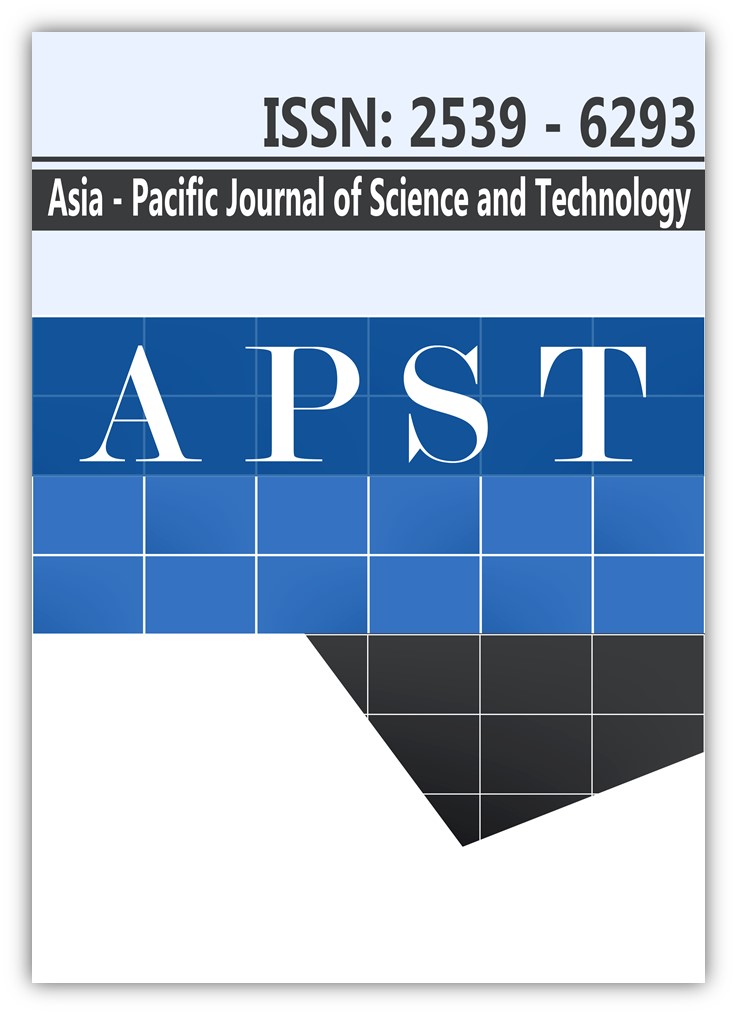Effects of infusion conditions on bioactive compounds and antioxidant activities of banaba herbal tea
Main Article Content
Abstract
Banaba (Lagerstroemia speciosa L.) is normally consumed as an herbal tea by infusing the banaba powder in hot water. However, the infusion method may influence the bioactive compounds, antioxidant activities, and enzyme inhibitor activities of the tea. Therefore, the objective of this study was to determine the effects of the infusion conditions on the bioactive compounds, antioxidant activities, and on the inhibition against α-glucosidase and α-amylase in banaba instant tea. Banaba extract powder (BEP) was produced by water extraction with the ratio of 1:10 and 1:8 (w/w) at 90 ºC and was dried using a spray dryer with the addition of 3% gum arabic. Then the effects of the infusion conditions were investigated by varying the water temperatures (80, 90, and 100 ºC) and the amount of BEP (2, 4 and 6 g). The investigated parameters were tannin content, total phenolic content (TPC), α-glucosidase inhibitor, α-amylase inhibitor and antioxidant activities dinitrosalicylic acid 1,1-diphenyl-2-pieryhdrazyl (DPPH) scavenging activity and Ferric Reducing Antioxidant Power (FRAP). The results indicated that tannin content, total phenolic content (TPC), α-glucosidase inhibitor, α-amylase inhibitor, DPPH and FRAP had significantly increased with increased amounts of BEP (p<0.05). This study also showed that higher water temperature had affected to bioactive compounds and antioxidant activities of the banaba tea (p<0.05). Infusion at 100 ºC showed the most effective condition, providing a high concentration of bioactive compounds, antioxidant activities, and α-glucosidase and α-amylase inhibitor activities. Therefore, tea infused at 100 ºC was selected to be mixed with lime juice. The addition of lime juice slightly decreased the bioactive compounds and antioxidant activities of the BEP infusion
Article Details
References
[2] Junaid S, Rakesh KN, Dileep N, Poornima G, Kekuda TP, Mukunda S. Total phenolic content and antioxidant activity of seed extract of Lagerstroemia speciosa L. Int J Drug Dev Res. 2013;5(4):286-292.
[3] Liu F, Kim JK, Li Y, Liu XQ, Li J, Chen X. An extract of Lagerstroemia speciosa L. has insulin-like glucose uptake-stimulatory and adipocyte differentiation-inhibitory activities in 3T3-L1 cells. Int J Nutr. 2001;131(9):2242-2247.
[4] Bhandari MR, Jong-Anurakkun N, Hong G, Kawabata J. α-Glucosidase and α-amylase inhibitory activities of Nepalese medicinal herb Pakhanbhed (Bergenia ciliata, Haw.). Food Chem. 2008;106(1):247-252.
[5] Judy WV, Hari SP, Stogsdill WW, Judy JS, Naguib YM, Passwater R. Antidiabetic activity of a standardized extract (Glucosol™) from Lagerstroemia speciosa leaves in type II diabetics: a dose-dependence study. J Ethnopharmacol. 2003;87(1):115-117.
[6] Hayashi T, Maruyama H, Kasai R, Hattori K, Takasuga S, Hazeki O, Tanaka T. Ellagitannins from Lagerstroemia speciosa as activators of glucose transport in fat cells. Planta Med. 2002;68(2):173-175.
[7] Tamilselvi N, Krishnamoorthy P, Dhamotharan R, Arumugam P, Sagadevan, E. Analysis of total phenols, total tannins and screening of phytocomponents in Indigofera aspalathoides (Shivanar Vembu) Vahl EX DC. J Chem Pharm Res. 2012;4(6):3259-3262.
[8] Piljac-Zegarac J, Samec D, Piljac A. In: Preedy VR, editor. Herbal teas: a focus on antioxidant properties. Tea in Health and Diseases Prevention. London: Elsevier; 2013. p. 129-140.
[9] Horžić D, Komes D, Belščak A, Ganić KK, Iveković D, Karlović D. The composition of polyphenols and methylxanthines in teas and herbal infusions. Food Chem. 2009;115(2):441-448.
[10] Zheng W, Wang SY. Antioxidant activity and phenolic compounds in selected herbs. J Agri Food Chem. 2001;49:5165-5170.
[11] Kim JS, Kwon YS, Chun WJ, Kim TY, Sun J, Yu CY, Kim MJ. Rhus verniciflua stokes flavonoid extracts have anti-oxidant, anti-microbial and α-glucosidase inhibitory effect. Food Chem. 2010;120(2):539-543.
[12] Ranilla LG, Kwon YI, Apostolidis E, Shetty K. Phenolic compounds, antioxidant activity and in vitro inhibitory potential against key enzymes relevant for hyperglycemia and hypertension of commonly used medicinal plants, herbs and spices in Latin America. Bioresour Technol. 2010;101(12):4676-4689.
[13] Atoui AK, Mansouri A, Boskou G, Kefalas P. Tea and herbal infusions: their antioxidant activity and phenolic profile. Food Chem. 2005;89(1):27-36.
[14] Thaipong K, Boonprakob U, Crosby K, Cisneros-Zevallos L, Byrne DH. Comparison of ABTS, DPPH, FRAP, and ORAC assays for estimating antioxidant activity from guava fruit extracts. J Food Compos Anal. 2006;19(6):669-675.
[15] Rehman S, Almas K, Shahzadi N, Bhatti N, Saleem A. Effect of time and temperature on infusion of tannins from commercial brands of tea. Int J Agri Biol. 2002;4(2):285-287.
[16] Perva-Uzunalić A, Škerget M, Knez Ž, Weinreich B, Otto F, Grüner S. Extraction of active ingredients from green tea (Camellia sinensis): Extraction efficiency of major catechins and caffeine. Food Chem. 2006;96(4):597-605.
[17] Astill C, Birch MR, Dacombe C, Humphrey PG, Martin PT. Factors affecting the caffeine and polyphenol contents of black and green tea infusions. J Agri Food Chem. 2001;49(11):5340-5347.
[18] Li YQ, Zhou FC, Gao F, Bian JS, Shan F. Comparative evaluation of quercetin, isoquercetin and rutin as inhibitors of α-glucosidase. J Agri Food Chem. 2009;57(24):11463-11468.
[19] Martin AE, Montgomery PA. Acarbose: an alpha-glucosidase inhibitor. Am J Health Syst Pharm. 1996;53(19):2277-2290.
[20] Langley-Evans SC. Consumption of black tea elicits an increase in plasma antioxidant potential in humans. Int J Food Sci Nutr. 2000;51(5):309-315.


